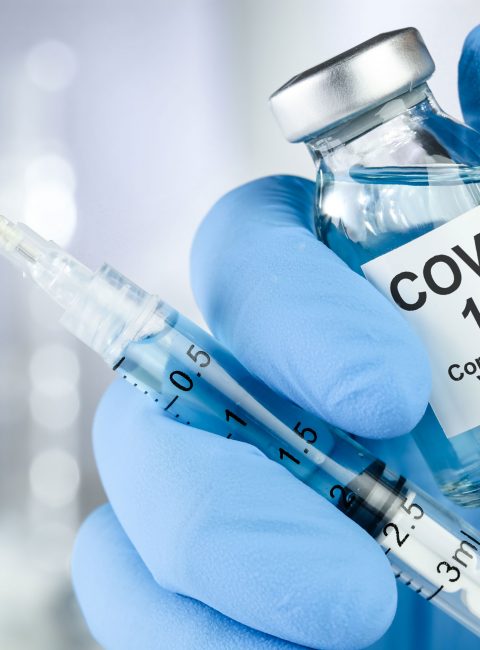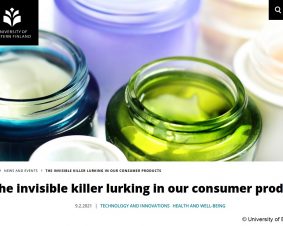 >
Spotlight February 2021: Nanoobjects in the COVID-vaccine – scientifically correct?
>
Spotlight February 2021: Nanoobjects in the COVID-vaccine – scientifically correct?
The COVID-19 pandemic induces very different reactions of people on the internet (https://www.cdc.gov/mmwr/volumes/70/wr/mm7002e1.htm) and in the social networks. Without following the conspiracy theories as “5G nanochip hidden in COVID vaccines” some news as “COVID vaccines induce allergic reactions” should be scientifically recognised. The picture from the 5G-nanochip whose plan goes viral on the internet is now exposed as fake and shows a guitar pedal. Quite different the recent news about allergic responses after injection of the COVID vaccine [1-3]. Is it true, and how about nanoparticles in vaccines?
Firstly, we should know that the active ingredient within the new vaccines are very sensitive molecules (the so-called mRNA) which must not only be cooled during transport but also would immediately be degraded after injection if not explicitly be stabilized by a special nano-shell. Here the principles of nanomedicine are adopted as the instable RNA-molecule is packed into a lipid layer containing stabilizing polymers (e.g. polyethylene glycol = PEG and others) [4, 5]. These polymers are part of the transport system which delivers the active agent to the cells in our body which start the anti-viral machinery. Unfortunately, such molecules may have a disadvantage because a small part of the population responds sensitive to polymers such as PEG which has been observed in 12 patients after getting the vaccine [1, 3]. The portion of sensitive people is very small but not negligible (currently more than 32 Mio. people have been vasccinated, as of January 2021), thus, it is important to know about the ingredients [please find the full list of the two recent vaccines in 3] and to discuss these with the treating physician. Scientific fact is: the size of the lipid vesicles (nano) is not of importance in relation to adverse effects. Ingredients such as the polymers of the shell around the active agent may induce problems, but the advantage of a COVID vaccination is indisputable.
If someone wants to know more about nanoparticles and vaccination, please visit the website of the Helmholtz Centre for Infection Research: https://www.helmholtz-hzi.de/en/news-events/stories/vaccination-with-nanoparticles/ .
Literature:
- de Vrieze, J (2021) Pfizer’s vaccine raises allergy concerns. Science, 371(6524): 10-11.
- Kleine-Tebbe, J et al. (2021) Severe allergic reactions to the COVID-19 vaccine – statement and practical consequences. Allergol Select, 5 26-28.
- Worm, M et al. (2021) Covid-19 vaccination and risk of anaphylaxis – Recommendations for practical management. MMW Fortschr Med, 163(1): 48-51.
- Editorial (2020) Nanomedicine and the COVID-19 vaccines. Nat Nanotechnol, 15(12): 963
- Abd Ellah, NH et al. (2020) Nanomedicine as a promising approach for diagnosis, treatment and prophylaxis against COVID-19. Nanomedicine (Lond), 15(21): 2085-2102.

Weitere Spotlights
Spotlight January 2023: Special issue on Methods and Protocols in Nanotoxicology published
In the first Spotlight of the new year, we present a special issue on methods and protocols in nanotoxicology published in the journal Frontiers in Toxicology. There are still too few harmonized protocols accepted by the scientific community. To improve this situation, project activities are started and special issues of journals like this one are […]
Read moreSpotlight August 2022: Three-stage model for the formation of micro- and nanoplastic particles.
Plastic pollution is a global problem that will continue to affect humanity for more than 100 years. There is the visible pollution, e.g. plastic debris in the environment, which leads to death for many animals (because they mistakenly think the plastic is food and eat it or because they get caught in the plastic waste). […]
Read moreSpotlight April 2021: Nanomaterials and Fake News – a commentary based on an example
In February 2021, the article “The invisible killer lurking in our consumer products” appeared, describing nanoparticles as a greater danger than Corona [1]. “The use of nanomaterials” would be “unregulated” and “nanomaterials are so small that they cannot be determined once they are part of a product”. So what is the truth of these statements? […]
Read moreSpotlight June 2023: New catalytic process for recovering important materials from composites in a single process
Previously virtually impossible and a huge problem: fibre-reinforced resin composites (epoxides) were not recyclable, and wind turbine rotor blades, for example, add up to a waste pile of 43 million tons by 2050. Researchers have now taken an important first step in “reprocessing” these composites and catalytically dissolving them so that the carbon fibres and […]
Read more


